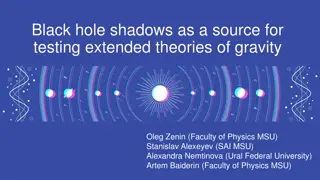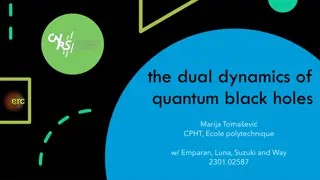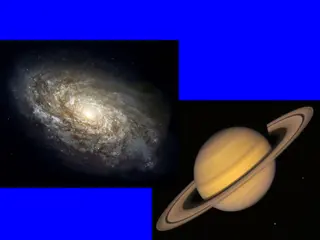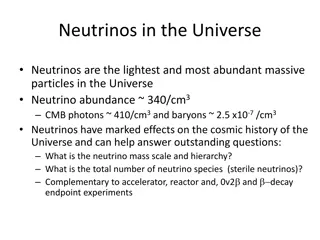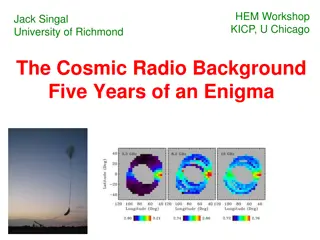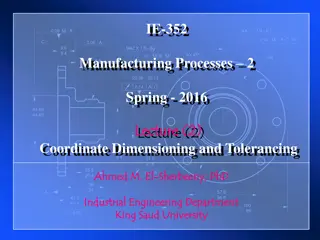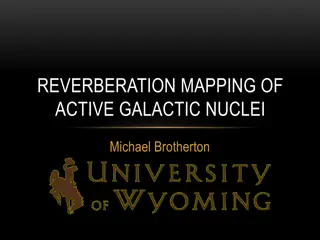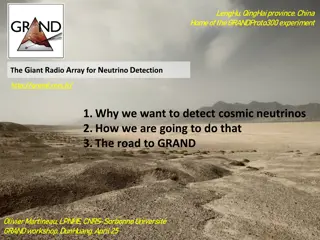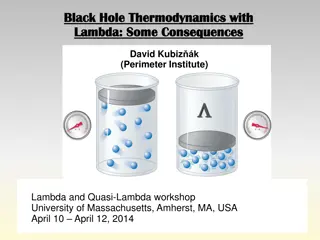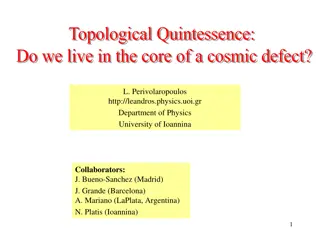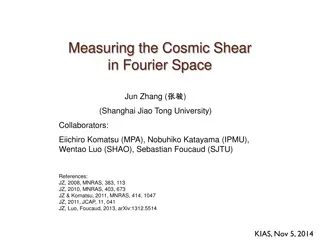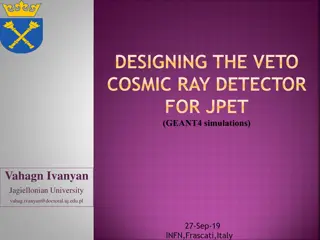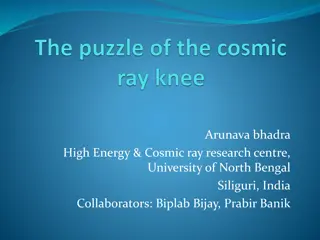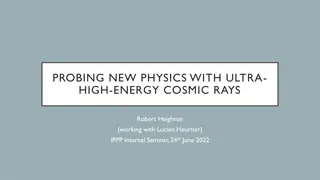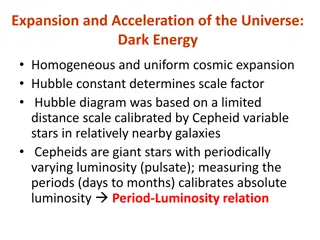The Universe: Black Hole or Cosmic Enigma?
The intriguing concept of the Universe being a black hole is explored through discussions of Schwarzschild metric, observable universe's density, spacetime diagrams, and proper time for inside observers. The reversal of time within a black hole leads to thought-provoking insights into the nature of the cosmos.
Download Presentation

Please find below an Image/Link to download the presentation.
The content on the website is provided AS IS for your information and personal use only. It may not be sold, licensed, or shared on other websites without obtaining consent from the author. Download presentation by click this link. If you encounter any issues during the download, it is possible that the publisher has removed the file from their server.
E N D
Presentation Transcript
Epilogue Black Hole Universe
Schwarzschild metric = metric in vacuum outside a spherical mass distribution 1 ??2= 1 ?? ?2??2 1 ?? ??2 ??2 sin2? ??2 ? ? Schwarzschild radius : rs= 2?? ?2 metric only valid in vacuum for r > R (radius of the object) if R < rs black hole 2 singularities : r = 0 r = rs(due to choice of coordinates)
Is the Universe a Black Hole ? radius of the observable universe : R ~ 4.1 1026m average matter density : ? ~ 10 27kg/m3 ? =4 3??3 rs= 2?? ?2= 8 ? 3?2??3~ 4.3 1026m even if the material universe is not much larger than the observable one, it should be a black hole (BH)
Spacetime diagram of a Black Hole inside light cone outside light cone rs null geodesics around a point source
Schwarzschild metric inside the Black Hole horizon r < rs 1 ?? < 0 ? 1 ??2= 1 ?? ?2??2 1 ?? ??2 ??2 sin2? ??2 ? ? > 0 < 0 time-like space-like for an inside observer : t is a space coordinate, r is a time coordinate by renaming r the space coordinate and t the time coordinate : 1 ?? ? 1 ?? ? 1 ??2 ??2 sin2? ??2 ??2= ?2??2 (ts= rs/c)
Proper Time for an inside observer at rest (r = ct, = ct) 1 ?? ? 1 ??2= ?2??2 1/2 ?? ? 1 ?? = ? ?? 2 solutions (? runs in the same direction as t or in the opposite one) both solutions are mathematically valid in general relativity which one should we choose ?
Reversed Time the Schwarzschild criterion indicate we are inside a BH inside the BH, the roles of r and t are switched the singularity is not a point in space but an instant in time we observe the universe expanding from an instant in time: the Big Bang the negative solution is the right one the singularity is an instant in our past the horizon is an instant in our future
What does Universe mean ? how do mainstream cosmologists avoid the conclusion that the universe is a black hole? a black hole has to be included in someting but the universe is everything it cannot be a black hole this is an abuse of language confusing different meanings of universe
Levels of Universes Level 1 : everything that exists, whole of spacetime Level 3 : observable universe Level 2 : material universe 3 2 2 = 1 or 2 1 mainstream cosmologists force 2 = 1
Reversed Time Black Hole Universe Model 1 (out) 1 (in) horizon 2 3 FLRW Schw in r t Schw out
FLRW inside Schwarzschild modeling a collapsing ball is very complicated unless it is a ball of uniform density and zero pressure FLRW metric that has to match the Schwarzschild metric at the boundary not well adapted to stellar BHs but much better to the material universe it is the same approximation as used in mainstream cosmology it is a consequence of the cosmological principle in that case no cosmological principle in RTBH cosmology just a 1stapproximation
Physical processes and boundary conditions proper time controls the physical processes no difference between standard and RTBH cosmologies there but : the boundary conditions are different ! standard cosmology : boundary (initial) conditions set at the singularity need an extreme fine-tuning to solve the horizon and flatness problems RTBH cosmology : boundary conditions set at the start of the collapse no fine-tuning needed, flatness and homogeneity are naturally explained
Flatness problem in standard cosmology, any departure from flatness increases with time universe needs to be extremely close to flat at the Big Bang in RTBH, any curvature at the start of the collapse will tend to be washed out if the horizon is far enough in the future, the universe will appear flat flatness problem solved
Horizon problem solution 1: no limit on the time before the black hole starts to collapse different regions had time to interact solution 2: r t inside the horizon what we perceive as a singular time corresponds to a point in outer space the Big Bang should appear the same from all directions horizon problem solved
Particle antiparticle asymmetry in standard cosmology, one begins with energy equal numbers of particles and antiparticles are expected in RTBH, one starts with particles asymmetry problem solved
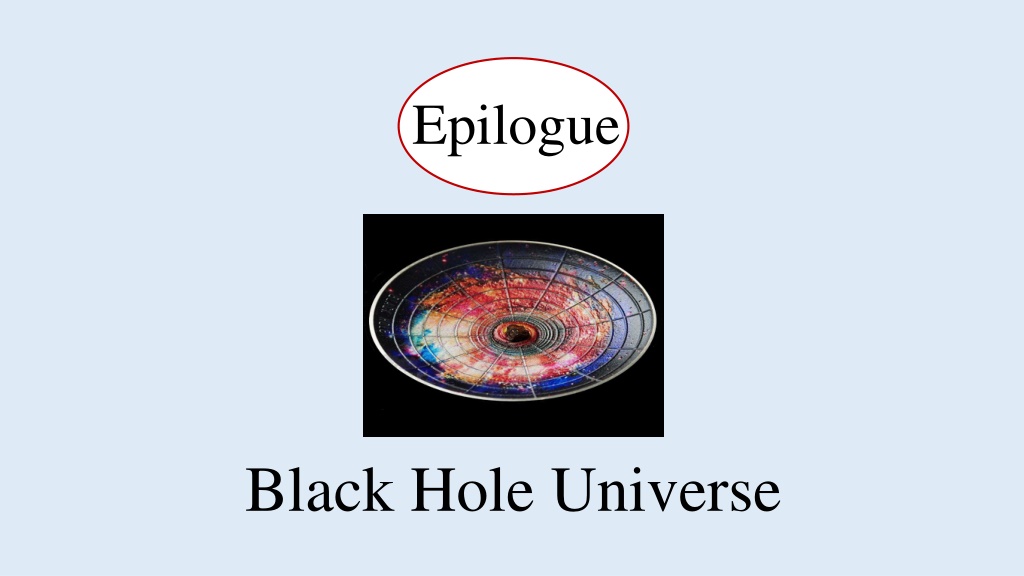

![[PDF⚡READ❤ONLINE] Black Hole Astrophysics: The Engine Paradigm (Springer Praxis](/thumb/21503/pdf-read-online-black-hole-astrophysics-the-engine-paradigm-springer-praxis.jpg)
